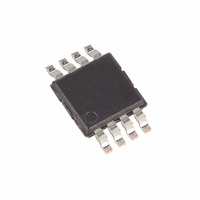MAX9945AUA+ Maxim Integrated Products, MAX9945AUA+ Datasheet - Page 8

MAX9945AUA+
Manufacturer Part Number
MAX9945AUA+
Description
IC OPAMP MOS-INPUT LP/LN 8-MSOP
Manufacturer
Maxim Integrated Products
Datasheet
1.MAX9945EVKIT.pdf
(14 pages)
Specifications of MAX9945AUA+
Amplifier Type
General Purpose
Number Of Circuits
1
Output Type
Rail-to-Rail
Slew Rate
2.2 V/µs
Gain Bandwidth Product
3MHz
Current - Input Bias
0.05pA
Voltage - Input Offset
600µV
Current - Supply
400µA
Current - Output / Channel
25mA
Voltage - Supply, Single/dual (±)
4.75 V ~ 38 V, ±2.4 V ~ 19 V
Operating Temperature
-40°C ~ 125°C
Mounting Type
Surface Mount
Package / Case
8-MSOP, Micro8™, 8-uMAX, 8-uSOP,
Input Offset Voltage
+/- 0.6 V
Input Bias Current (max)
50 fA
Common Mode Rejection Ratio (min)
94 dB
Supply Current
850 uA
Maximum Operating Temperature
+ 125 C
Minimum Operating Temperature
- 40 C
Input Voltage
- 0.3 V to + 40 V
Maximum Power Dissipation
387.8 mW
Mounting Style
SMD/SMT
Operating Temperature Range
- 40 C to + 125 C
Lead Free Status / RoHS Status
Lead free / RoHS Compliant
-3db Bandwidth
-
Lead Free Status / Rohs Status
Lead free / RoHS Compliant
38V, Low-Noise, MOS-Input,
Low-Power Op Amp
For voltage-output sensors, a noninverting amplifier is
typically used to buffer and/or apply a small gain to, the
input voltage signal. Due to the extremely high imped-
ance of the sensor output, a low input bias current with
a small temperature variation is very important for these
applications.
The MAX9945 operates from a +4.75V to +38V, V
erenced power supply. Bypass the power-supply
inputs V
with a 0.1µF ceramic capacitor in parallel with a 4.7µF
electrolytic capacitor, placed close to the leads.
A good layout is critical to obtaining high performance
especially when interfacing with high-impedance sen-
sors. Use shielding techniques to guard against para-
sitic leakage paths. For transimpedance applications,
for example, surround the inverting input, and the
traces connecting to it, with a buffered version of its
own voltage. A convenient source of this voltage is the
noninverting input pin. Pins 1, 5, and 8 on the µMAX
package are unconnected, and can be connected to
an analog common potential, or to the driven guard
potential, to reduce leakage on the inverting input.
A good layout guard rail isolates sensitive nodes, such
as the inverting input of the MAX9945 and the traces
connecting to it (see Figure 1), from varying or large volt-
age differentials that otherwise occur in the rest of the
circuit board. This reduces leakage and noise effects,
allowing sensitive measurements to be made accurately.
Figure 1. Shielding the Inverting Input to Reduce Leakage
8
_______________________________________________________________________________________
CC
and V
EE
to a quiet copper ground plane,
Power-Supply Decoupling
Layout Techniques
IN+
IN-
MAX9945
EE
ref-
V
OUT
Take care to also decrease the amount of stray capaci-
tance at the op amp’s inputs to improve stability. To
achieve this, minimize trace lengths and resistor leads
by placing external components as close as possible to
the package. If the sensor is inherently capacitive, or is
connected to the amplifier through a long cable, use a
low-value feedback capacitor to control high-frequency
gain and peaking to stabilize the feedback loop.
Figure 2. Input Differential Voltage Protection
+
-
10kΩ
10kΩ
1
2
4
3
+
MAX9945
μMAX
IN+
IN-
MAX9945
7
6
5
8











